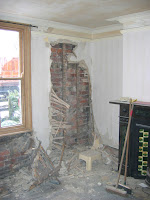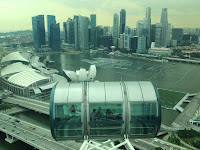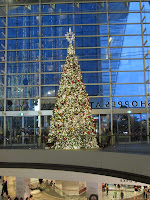Singapore Sling
29 Nov.
Parking up at Manchester Airport. Slight shortage of lime chipping surface, car almost swallowed by potholes. Grounded a couple of times, saved from total immersion by ice floes. Ditch the winter coat? Emphatically not. 20 mins waiting for an airport bus at 0700 in sub zero Manchester = layers.
Plane delayed 2hrs due to snow en route in. What’s another 2 hrs on a 14hr flight? Route back out to Singapore via Munich. For those of us of a certain age, flying from Manchester and coming in to land in Munich in driving snow evokes memories. Better not thought about of course. Safely in and out after a 30 min leg stretch on German soil and lengthy de-icing. Singapore Airlines thoroughly recommended. Plenty of decent food and drink and excellent entertainment selection. Much of my entertainment consisted of finishing the cycling club accounts, formulating a back up strategy for Pickering flood scheme and a query about wind turbines. Sad really, but it’s an awful lot of time to kill when you can’t sleep on planes. Apparently the air hostesses are rather attractive in their native attire, but I didn’t really notice - repeatedly.
30 Nov
Arrival1000 (0200 UK), flying in over the Malacca Straits with the city in full view. No shortage of spectacular high rise buildings or ships in the straits. Astounding density of shipping puts the English Channel to shame. Outside the air conditioned airport, the hot and humid reality of monsoon season in equatorial Singapore hits hard. Almost 40 deg C variation on Manchester.
Couple of hours sleep and still slightly jetlag blitzed, it was out on the town. Excellent lobster at Ms Tan’s accompanied by refreshing coconut drink - a straw in the top of a hacked open fresh coconut (not the old brown shrivelled nut we’re used to). Sounds decadent, but just simple local fare. Couple of local beers, one very potent sakae (with an aftertaste not unlike premium diesel) and slept soundly.
1 Dec
Staying with old friend Anver, who‘s been working here for 2 years, so good training course on local etiquette, shopping, eating and public transport. The buses and MRT (Metro) are cheap, regular, highly efficient and integrated. Pay with one simple top up card, swiped as you get on and off. They have a huge advantage - massive demand. Cars aren’t cheap to buy, but a Certificate of Entitlement (to drive the vehicle) must first be bought for about £36,000 or more - depending on size, lasting 10 years.
Shopping trip to a bustling local supermarket, with lots of unfamiliar fresh produce and fresh fish, crab and frogs live in tanks - but evidently not for long!
There is obviously huge wealth and growth, based on the strategic location for trading and money markets. Singapore is heavily populated, multi-cultural, multi-racial, but still a remarkably safe, clean and well ordered society. It comes at a cost. Strictly enforced capital and corporal punishment and hefty fines. Virtually no petty crime or vandalism. You feel quite safe at any time of the day or night - even in the city centre or housing estates. Young women will walk alone at night.

No respite from the work hard, play hard ethos, so off we went for a night at the world famous Raffles Hotel. A Singapore Sling was obligatory in the place it was invented back in the old colonial days. Back to the safety of Tiger Beer thereafter. Raffles is one of the few lovely old buildings to survive the onslaught of steel, concrete and glass high rise capitalism. Although there are occasional claims of being environmentally sensitive, it bears all the hallmarks of the worst lip service. I’ll draw a veil over the rest of the night other than to say a few beers in live music venues and tucked up by 0620. Ahem.
Thereafter
Although our friend Anver is a relatively affluent businessman, he’s risen through the ranks from humble beginnings in Manchester, so although some of our time was spent as ‘gwilo’ (derogatory Chinese term for white men) tourists, almost as much was spent going native. It gives you more of a flavour of the real Singapore and of working long hard hours for subsistence wages. Family and education are a major priority here. It’s an example for the multitude in the UK that take their education for granted and squander the opportunity. The Singapore kids are likely to have a bloody tough life without qualifications.
A trip to the serious tourist areas for a ‘flight’ on the flyer (bigger version of the London Eye) and visit to the Marine Bay complex and Art Gallery - quite superb Lego exhibition. As you’d expect, lots of photo’s from the Flyer of the towering bastions of capitalism and the massive container terminal along the coast.
Marina Bays Sands complex is one of the more vast and opulent shopping malls. Think of any swankpot designer label and they have a large shop there. I find these places dull and rather nauseating in equal measure, so enough of that - although the air conditioning is quite welcome. A rare plus point among the opulence, Christmas decs and piped music - a choir of about 15 immaculately turned out students (no resemblance to my college days!) with an impromptu performance of Christmas music. Quite wonderful. Enough to moisten the eyes in a desert of decadence.

As an acknowledged exercise junkie sans bike, I tried a couple of runs. Not fantastic in such an urban environment. It’s similar to being stuck in any major metropolis when you’re used to the fell and moorland. I was missing my off road Newtondale tracks and paths. Bathed in sweat and getting perilously close to heat exhaustion by trying to push hard gives an inkling of the inhumanity suffered from slave labour during the war years. We’d observed the city centre roads being closed for the Singapore Marathon, but missed it due to extensive hanging around live music venues (again) until way past my bedtime. I was hard pushed to survive an 8 mile run in this climate, so 26.2 miles didn’t bear thinking about. Cycling in Singapore would probably be like cyling in central London - only without the dedicated facilities that have appeared there in recent years. I don't think they'll ever be a world power in pro cycling.

A few shopping trips were classed as essential, with separate visits to Chinatown, Little India and Kampong Glam (Little Malaysia). These are the areas where some of the many immigrants settled and remain seething masses of small alleyways, shops, stalls, cafes etc. It’s miraculous that such a profusion of small shops selling cloth, jewellery, clothing etc can all survive. Once again, the lack of any threat, petty crime or litter is remarkable in relatively poor areas. Undoubtedly, there is still crime, but strictly enforced laws keep it to a minimum. Only the police are allowed firearms. The penalty for smuggling drugs or firearms is death. Many creeds, colours and religions co-exist cheek by jowl with little or no sign of conflict. It’s not always been that way of course. A lot of what is good about Singapore seems to stem from long-term government planning since the 1960s, working to a far-sighted 25 year plan.

Visiting in the monsoon season meant frequent torrential downpours and violent thunderstorms. Each of our shopping trips above were disrupted by the rain. It’s so heavy at times that you can’t even scuttle across the road from one alley to another. Shopkeepers are well versed in quickly sweeping up their wares under cover and raising racks above the gushing water.
Internal walkways connect most shops. True retail masochists can retreat to one of the multitude of malls. Naturally, I was intrigued by the effective network of storm drains that cover the whole island, building from small channels to huge canals. A costly but essential network when it’s necessary to move huge quantities of water on a regular basis.
They even have a coastal barrage, which has turned the Singapore River estuary into a huge freshwater reservoir. Without the effect of high tides combined with heavy rain, flooding problems in certain parts of the city have been pretty much eradicated and the old harbour area can be used relatively safely for recreational uses.
A lot of land has been reclaimed from the sea. The extensive port area has been overtaken by the business district, making the land far too valuable for mere maritime trade, so a completely new container port has been built further west, with a gradual move across in progress. It’s hard to comprehend the sort of money that’s being invested - much of it from the usual suspects, Russia and China.
Probably of more interest to members was our trip to the Botanic Gardens and Orchid collection. A fantastic array of trees, shrubs and plants covering quite a large area. The trees grow to an amazing size in a relatively short time due to the heat and rainfall, some with huge buttress roots, aerial roots and lianas.
Sadly, a small area of original rain forest is one of the last remaining on the island. Last gasp conservation - they paved paradise, put up a parking lot…. Tra la la.
Another outdoor adventure was the aerial walkway from Hort Park to Harbourfront. You’re mostly on a steel walkway, high above lush vegetation. It’s a sinuous route between developed areas and no doubt terrain spared from the bulldozer by being too severe for development.
A welcome green lung for the city dweller. A small sad remnant to the countryman. We saw very little wildlife - one small vivid green snake snoozing in the sunshine, a few squirrels, although plenty of birds and butterflies. Fortunately mosquitoes are kept under control, but Dengi Fever is still a problem.
Clarke Quay was essential viewing, but only for a fleeting visit. Damn right at 9 quid a pint! This is full on Gwilo territory - full of trendy riverside malls, clubs and bars…. and trendies. Reputedly a seething mass on New Year’s Eve to match the roundabout in Pickering, but we’ll give it a miss. With our host’s local knowledge, we did find a superb blues/rock band at the Crazy Elephant to herald yet another somewhat debauched, musical and very long night, including a stop-off at Orchard Towers to view the night safari (otherwise known as four floors of something-or-other. The name escapes me).

A couple of buildings are worthy of a mention. The Divine Bar at Park View Square is the most sumptuously massive art deco edifice you’re ever likely to see. Quite superb, it wouldn’t look out of place in Gotham City. Ironically, it’s only about 10 years old and at the base of a tower block containing a hotel and apartments. That doesn’t alter the fact that the craftsmanship on a massive scale is breathtaking.
Again the cost is hard to imagine, although the price of a bottle of wine went some small way towards the investment return. The bottle is collected by a ‘wine fairy’ on a trapeze contraption from a 20-30ft high wine rack. Yes, honestly.
Somewhat more traditional is the waterfront Fullerton Hotel, one of the few colonial throwbacks, which in a former life was Singapore’s main post office and still contains red pillar box no. 1. Grand Victorian architecture now dwarfed by skyscrapers, but even here a rather poorly proportioned upward extension has been popped on the top.
13 Dec
Long long day. A few hours around the Museum of Singapore to tidy up our ‘to do‘ list, then back for an hour in the gym to set me up for the purgatory of sitting still for 16 hours. Even with full on aircon, it still needs 10 mins in the pool to cool down enough for a shower. Last supper and fond farewells to our wonderful host. Clock spinning 8 hours backwards and dawn chasing us across the globe. Malaysia, India, Kandahar, Tbilisi, Sevastopol, Odessa, Vienna, Munich, Canvey Island. -18c at the Munich stopover. Bracing ourselves for ice-breaking in the cold light of a Manchester dawn and a weary 3hr drive home with nipped fingers and toes. Before you know it, we’ll be changing beds and cleaning loos. It’ll be good to be back in the real world but bugger winter. Give me 32 degrees any time.

































